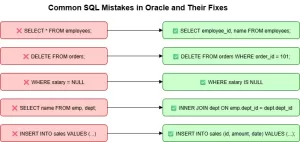
Parquet vs CSV: Which File Format is Better
In the world of enterprise automation, data handling efficiency is a crucial factor, especially when dealing with large data sets like Oracle E-Business Suite (EBS) or other similar application. Python has become a preferred choice for automating tasks, but the choice of data format significantly impacts performance and scalability. Two of the most commonly used formats are Parquet vs. CSV. In this blog, you will understand the comparion of parquet file vs csv through real-world scenarios in Python and Oracle EBS.
Table of Contents
Parquet vs. CSV: Which File Format is Better
Parquet vs. CSV: Performance and cost
Parquet vs. CSV: Key Comparisons
Real-World Case Study for Parquet vs. CSV: ERP Data Processing
Understanding Parquet vs. CSV
CSV and Parquet are two popular data formats for storing and querying tabular data. Actually CSV is a simple and ubiquitous format, while Parquet is a columnar storage format designed for large and complex data sets.
CSV (Comma-Separated Values)
CSV is a simple and widely used data format. It represents tabular data in plain text, making it human-readable and easy to process. However, CSV lacks schema enforcPlement, compression, and efficient data retrieval, leading to performance issues in large-scale automation.
Advantages of CSV:
- Easy to create, read, and debug
- Supported by many tools and frameworks
Disadvantages of CSV:
- Does not support complex data types or nested structures
- Does not preserve the schema or data types of the columns
- Does not support efficient compression or encoding schemes
- Does not allow skipping irrelevant data when querying
Parquet File Format
Parquet is a columnar storage format optimized for analytical queries and efficient compression. Unlike CSV, Parquet stores data column-wise, significantly reducing storage costs and improving read performance. It is widely used in data warehousing and big data applications.
Advantages of Parquet:
- Supports complex data types and nested structures
- Stores the schema and data types of the columns within the file
- Uses efficient compression and encoding schemes
- Allows skipping irrelevant data when querying
Parquet vs. CSV: Performance and cost
Apache Parquet file format can be up to 10 times smaller than CSV file, and up to 2 times faster to read and write. Parquet files are also compatible with many data processing frameworks and query services.
Parquet files are a better choice than CSV files for storing and querying large data sets, as they offer higher efficiency, lower cost, and greater flexibility. However, CSV files are still useful for smaller or simpler data sets, or for applications that require wide compatibility and easy debugging.
Parquet vs. CSV: Key Comparisons
| Feature | Parquet | CSV |
|---|---|---|
| Storage Efficiency | High (columnar compression) | Low (raw text) |
| Read Performance | Faster (column pruning, optimized I/O) | Slower (row-wise reading) |
| Write Performance | Slower (due to compression overhead) | Faster (simple text writing) |
| Schema Enforcement | Yes (data types, structure) | No (free-form text) |
| Compatibility | Limited to certain tools | Universally compatible |
| Best Use Case | Large datasets, analytics, automation with structured data | Small datasets, quick exports, simple integrations |
Real-World Case Study for Parquet vs. CSV: ERP Data Processing
An enterprise using Oracle EBS needs to automate financial reporting by extracting, transforming, and loading (ETL) large transaction logs into a Python-based analytics pipeline.
Challenges with CSV:
- The extracted CSV files are large (several GBs), leading to slow I/O operations.
- Parsing CSV takes significant memory and CPU due to row-wise processing.
- Schema inconsistency causes failures in downstream analytics.
How Parquet Solves These Issues:
- Parquet reduces file size due to columnar compression, saving storage costs.
- Faster data retrieval using columnar scanning, reducing query execution time.
- Schema enforcement ensures consistent data types, reducing transformation errors.
Implementation in Python:
In the following block of Python code you will definately understand parquet vs. csv.
import pandas as pd
# Extracting data from Oracle EBS
query = "SELECT * FROM GL_JE_LINES"
data = fetch_data_from_oracle_ebs(query) # Custom function to fetch data
# Converting to DataFrame
df = pd.DataFrame(data)
# Saving as CSV
df.to_csv("transactions.csv", index=False)
# Saving as Parquet
df.to_parquet("transactions.parquet", engine='pyarrow', compression='snappy')You can easily extract data from Oracle Database(Oracle EBS) using Python.
Performance Metrics (Real Data Processing)
- CSV file size: 5GB | Parquet file size: 800MB
- CSV read time: 120 seconds | Parquet read time: 15 seconds
- CSV write time: 30 seconds | Parquet write time: 60 seconds
Conclusion: Parquest File or CSV? Which Format to Choose?
If your Oracle EBS/Other system involves large datasets with frequent reads and analytical queries, Parquet is the better choice due to its storage efficiency and performance benefits. However, if you need a lightweight, universally compatible format for quick exports and simple integrations, CSV remains a viable option.
By carefully evaluating your automation requirements, you can leverage the right format to optimize data processing in Python and Oracle EBS. Choosing Parquet over CSV can lead to substantial cost savings, improved processing speeds, and enhanced data consistency in enterprise automation workflows.




Pingback: Outbound Interface in Oracle Apps R12: A Real-World Case Study
Pingback: How to Convert Parquet to CSV file format in Python – Enodeas
Pingback: How to Convert CSV to Parquet, JSON Format